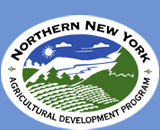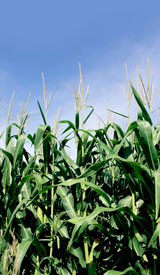


May 9, 2007
Contacts: Dr. Quirine M. Ketterings, Cornell
University, 607-255-3061
Michael E. Hunter, Cornell Cooperative Extension of Jefferson County,
315-788-8450
Mike Kiechle, 315-642-5776
Photo opp: depending upon NNY weather conditions, corn planting will
begin on the Kiechle farm May 10-June 1. Call Kara at 465-7578 to check
on photo/film and interview opportunities.
NNY Farmer Happy to Save Money Not Over-Fertilizing Corn
Philadelphia, NY -- After participating in a Northern New York
Agricultural Development Program-funded research project, Mike Kiechle
now spends about $700 less to grow corn to feed his 110 dairy cows in
Philadelphia, NY.
�Participating in this Northern New York Ag Development project was a
win-win situation. It didn�t cost me anything and ended up saving me
money,� Kiechle says.
Kiechle collaborated on a precision nitrogen (N) management project with
project leader Dr. Quirine M. Ketterings, an associate professor of crop
and soil sciences at Cornell University; Cornell Cooperative Extension
of Jefferson County Field Crops Educator Michael E. Hunter; and Cornell
University graduate student Joseph Lawrence, who grew up in NNY on a
Cape Vincent dairy farm.
�Based on research conducted in Northern New York and combined with
similar work elsewhere in New York state, we conclude that first-year
corn will benefit from a small starter nitrogen application of about 30
lbs. per acre and does not require any additional N beyond the starter,�
Ketterings says.
Lawrence says, �This conclusion suggests there is no need to use any
nitrogen management tools, such as the PSNT, chlorophyll or ISNT. For
farmers that would normally sidedress first-year corn, this could mean
substantial savings in fertilizer and application costs � a minimum of
$30 to $40 per acre.�
Prior to the research trial on his farm, Kiechle applied 50 to 60 pounds
of nitrogen in the starter application for a first-year corn crop in a
field that was previously harvested for grass or alfalfa or a mix of the
two. He grows about 70 acres of corn each year and in 2007 will use half
the nitrogen he has used in the past on his first-year corn. Kiechle is
one of 16 farm owners and managers who hosted the precision nitrogen
management trials in 2005 and 2006.
Lawrence says none of the sixteen first-year corn trials responded to
sidedressing with nitrogen indicating that even the grass sods that were
killed in the fall still produced enough nitrogen to feed the following
year�s corn crop.
�Some sites did not respond to sidedress in the second year of the
trials either, even when no manure was applied,� Lawrence says.
�After learning the results of the research, I cut back to no more than
30 pounds. That will save me about $10-12 per acre. That may not seem
like a lot of money, but times are tight and nitrogen is expensive, so
it makes sense to fine tune the application and not use more nitrogen
than is used,� Kiechle says.
He says in the past he had not given manure enough credit for adding
nitrogen to the soils where he grew corn. Kiechle says after cutting the
excess nitrogen in his applications his corn began to look better and
the quality of the silage improved with increased energy levels and
minimally lower crude protein.
�The corn with the excess nitrogen grew taller with a smaller stalk
causing the corn to lodge (tip over) easier and forcing us to chop the
corn before I wanted to. The ears were also smaller and produced less
grain. In the trial the corn that received less nitrogen was shorter,
sturdier and produced more corn in the silage,� Kiechle says.
Yields not only did not suffer with less N, they improved.
�This trial showed I was just wasting money to apply more nitrogen to
the first year corn. It produced no more yield than the lesser amount,�
Kiechle says. �In past years, I had been happy to harvest 18 tons on my
clay soils, so when we harvested 20 tons of corn silage in 2006 I was
excited about the results,� Kiechle says.
Lawrence says working with Kiechle and other participating farmers on
their farms is vital to agricultural research work. Hunter adds, �With
the rising costs of nitrogen fertilizer and the importance of sound
nutrient management on farms, we need research projects such as this one
to provide answers to help us make better decisions on the farm.�
Kiechle says, �Let�s not forget to credit the Northern New York
Agricultural Development Program for providing the funding to make this
work possible. That funding combined with the resources of Cornell and
its Extension program made this project possible.�
Field Crops Educator Michael E. Hunter with Cornell Cooperative
Extension of Jefferson County, who participated in the research, says,
�The combination of farmers, Extension and Cornell University working
together on research projects is extremely valuable in the sense that we
form a team that is focused on finding the answers to questions and
learning together. Farmers are an extremely important part of the
research.�
Northern New York Agricultural Development Program Co-Chair and dairy
farmer Jon Greenwood says, �On-farm trials of precision nitrogen
management research is a good way to marry science and practicality with
the goal of developing efficient, cost-effective production practices
that are environmentally-friendly and can be used by farmers throughout
the Northern New York region.� # # #
